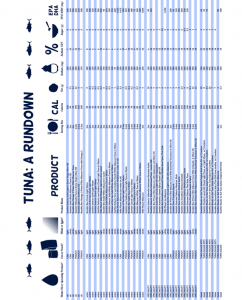Tuna: What Do You Know About It?
Remember when you could buy tuna canned in water or oil and these were the only options? Now the choices seem endless. Can or pouch? Light, albacore, or yellowfin? Lemon Dill or Spicy Thai Chili? Add in nutrition concerns like sodium and omega-3 fatty acids, and buying a simple can of tuna can be overwhelming! To cut through all the craziness, let’s take a closer look at tuna… Health BenefitsTuna, like other fatty fish, is known for its abundance of heart-healthy omega-3 fatty acids, both EPA and DHA. The American Heart Association recommends that most people eat at least two three-and-a-half-ounce servings of fish per week. People with heart disease should eat even more.Pouch vs. CanWith tuna in a pouch, you don’t need a can opener and there’s no messy draining. You can also find easy-to-open cans and “bowls” that don’t have to be drained. Tuna in a pouch is only cooked once, as opposed to most canned tuna, which is cooked twice. According to Starkist, this pouch processing leaves the texture of tuna firmer, and results in a fresher-tasting product.Light vs. WhiteMost packaged tuna is white (albacore) or light (skipjack, yellowfin, or tongol). White tuna has a meaty texture and tastes milder than light tuna. White and light tuna also differ in omega-3 and mercury content.EPA and DHA: Omega-3sAccording to the USDA nutrient database, white tuna has twice as much EPA and DHA as light tuna, but you really need to check the label to make sure your tuna is a good source. The Food and Drug Administration allows manufacturers to put omega-3 heart health claims on labels for tuna. A tuna that makes health claims must also list the amount of EPA and DHA per serving. Of the major brands, Bumble Bee Omega-3 Prime Fillet Albacore Tuna has one of the highest amounts of EPA andDHA (500 m/serving).SafetyWhile white tuna has more EPA and DHA, it also has more methyl mercury than light tuna. Experts say that healthy people don’t need to limit their fish intake, and that the benefits of omega-3 fatty acids outweigh any negatives from mercury contamination. However, pregnant women, women who might become pregnant, nursing mothers, and young children should choose more low-mercury fish (up to 12 ounces per week), including light tuna, and limit white tuna to six ounces per week.Oil vs. WaterOn average, tuna in water has about half the calories of tuna in oil. Many specialty tuna products also have more calories than you might expect. Check the label to find out which option is best for you.SodiumYour best bet is plain tuna — either low sodium (140mg/serving) or very low sodium (35mg/serving) versions. Some specialty tuna products have 2 to 11 times more sodium than plain tuna! For example, Starkist Gourmet Selects Thai Style Tuna has 430mg of sodium per serving. Tuna salad lunch kits that come with crackers are even worse.SugarNo, tuna doesn’t contain any carbs or sugars. But a few of the specialty products add a little bit of sugar. Watch for items like Bumble Bee Seasoned Tuna Medley Spicy Thai Chili Bowl. If you eat one serving (he whole 4-ounce bowl) you’ll get more than two teaspoons of added sugar.Bottom LineChoosing the right tuna is tough. Bumble Bee Omega-3 Prime Fillet Albacore Tuna provides lots of EPA+DHA and 6% of the Daily Value for sodium, which is not that bad compared to other tuna products. On the other hand, Starkist Selects Very Low Sodium Chunk White Tuna in Water is the lowest in sodium and provides a good amount of EPA+DHA at 220mg/serving. Which tuna type is your favorite?Don't miss this exhaustively-researched chart that lays out the key differences between over 50 different types of tuna!
Health BenefitsTuna, like other fatty fish, is known for its abundance of heart-healthy omega-3 fatty acids, both EPA and DHA. The American Heart Association recommends that most people eat at least two three-and-a-half-ounce servings of fish per week. People with heart disease should eat even more.Pouch vs. CanWith tuna in a pouch, you don’t need a can opener and there’s no messy draining. You can also find easy-to-open cans and “bowls” that don’t have to be drained. Tuna in a pouch is only cooked once, as opposed to most canned tuna, which is cooked twice. According to Starkist, this pouch processing leaves the texture of tuna firmer, and results in a fresher-tasting product.Light vs. WhiteMost packaged tuna is white (albacore) or light (skipjack, yellowfin, or tongol). White tuna has a meaty texture and tastes milder than light tuna. White and light tuna also differ in omega-3 and mercury content.EPA and DHA: Omega-3sAccording to the USDA nutrient database, white tuna has twice as much EPA and DHA as light tuna, but you really need to check the label to make sure your tuna is a good source. The Food and Drug Administration allows manufacturers to put omega-3 heart health claims on labels for tuna. A tuna that makes health claims must also list the amount of EPA and DHA per serving. Of the major brands, Bumble Bee Omega-3 Prime Fillet Albacore Tuna has one of the highest amounts of EPA andDHA (500 m/serving).SafetyWhile white tuna has more EPA and DHA, it also has more methyl mercury than light tuna. Experts say that healthy people don’t need to limit their fish intake, and that the benefits of omega-3 fatty acids outweigh any negatives from mercury contamination. However, pregnant women, women who might become pregnant, nursing mothers, and young children should choose more low-mercury fish (up to 12 ounces per week), including light tuna, and limit white tuna to six ounces per week.Oil vs. WaterOn average, tuna in water has about half the calories of tuna in oil. Many specialty tuna products also have more calories than you might expect. Check the label to find out which option is best for you.SodiumYour best bet is plain tuna — either low sodium (140mg/serving) or very low sodium (35mg/serving) versions. Some specialty tuna products have 2 to 11 times more sodium than plain tuna! For example, Starkist Gourmet Selects Thai Style Tuna has 430mg of sodium per serving. Tuna salad lunch kits that come with crackers are even worse.SugarNo, tuna doesn’t contain any carbs or sugars. But a few of the specialty products add a little bit of sugar. Watch for items like Bumble Bee Seasoned Tuna Medley Spicy Thai Chili Bowl. If you eat one serving (he whole 4-ounce bowl) you’ll get more than two teaspoons of added sugar.Bottom LineChoosing the right tuna is tough. Bumble Bee Omega-3 Prime Fillet Albacore Tuna provides lots of EPA+DHA and 6% of the Daily Value for sodium, which is not that bad compared to other tuna products. On the other hand, Starkist Selects Very Low Sodium Chunk White Tuna in Water is the lowest in sodium and provides a good amount of EPA+DHA at 220mg/serving. Which tuna type is your favorite?Don't miss this exhaustively-researched chart that lays out the key differences between over 50 different types of tuna! Here's a PDF handout version of the chart, just for you!
Here's a PDF handout version of the chart, just for you! By Hollis Bass, MEd, RD
By Hollis Bass, MEd, RD

